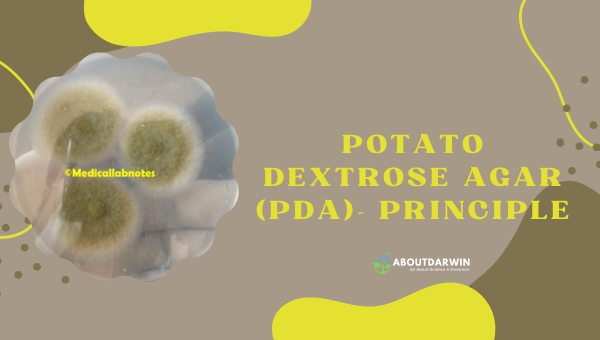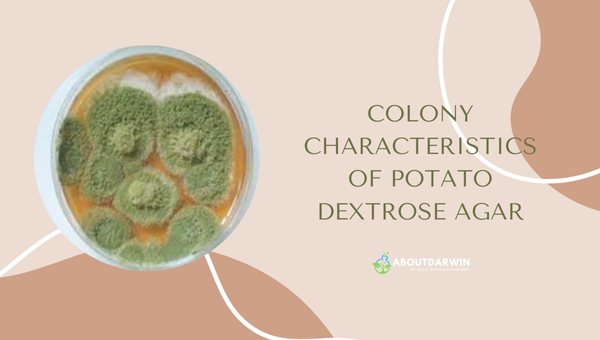Physical Address
304 North Cardinal St.
Dorchester Center, MA 02124
Do you find yourself confused about the principle and uses of Potato Dextrose Agar (PDA)? Maybe you are baffled by its composition or how to identify colonies on it. You have made your way to the right place!
This article is not just an informative guide but is crafted for everyone with a curiosity about PDAs or those who work with this powerful medium in a lab. It is time to jump into exploring Potato Dextrose Agar’s enticing world!
Potato Dextrose Agar, popularly known as PDA, is an excellent medium used primarily in microbiology and mycology labs around the world. Its essence lies in its versatility- it aids scientists in growing and identifying various types of fungi, including yeasts and molds!
Understanding its principle lets us better appreciate this unique tool’s abilities while unraveling its uses, which provides an expansive world within scientific studies.
Contents [hide]
Before we jump into the deep, let’s get a solid grasp of what Potato Dextrose Agar (PDA) actually is.

Potato Dextrose Agar – fondly dubbed PDA – is truly an unsung hero in the realm of microbiology. Its primary function lies in its incredible ability to foster fungal growth, specifically yeast and molds. This seemingly humble culture medium packs a serious punch, commonly composed of dehydrated potato infusion and dextrose, plus agar.
But why potatoes, you may ask? Well, potatoes act as an abundant source of nutrients that help promote extensive fungal growth. Meanwhile, dextrose serves as the main carbohydrate source necessary for sporulation and pigment production in fungi.
These two components combined form a low pH environment ideal for supporting fungal cultivation while inhibiting bacterial propagation – this makes PDA vital to research and studies involving fungi.
Also Read: Unlock DNA Discoveries: Free DNA Upload Websites Guide
So now we know what PDA is fundamentally made up of, but exactly how useful could it be? As it turns out, quite so! Here are some key uses that make PDA invaluable:
Simply put, if there’s analysis or research involving fungi on the cards – ones particularly focusing on yeast and molds – one could not hope for a better tool than good old Potato Dextrose Agar!
Beyond these common uses, PDA’s versatility finds it a variety of applications across many fields. Foremost among these would be scientific studies – particularly in microbiology and mycology.
In Microbiology, PDA is commonly used for isolating and cultivating yeast and molds from dairy products and other food types. This helps in determining the microbial quality of such products.
In the realm of Mycology – the study of fungi – it’s hard to undermine PDA’s importance. Here’s why:
Every time I think about it – this simple medium derived from humble potatoes has been pivotal to incredible advancements in these scientific fields. It just goes on to show how simplicity can sometimes lead to astonishing outcomes!
Also Read: Planning a Perfect Family Reunion: A Comprehensive Guide
Understanding the composition of a PDA is integral for appreciating its functionality and effectiveness. Each component within it serves a unique and crucial role in promoting the growth of microorganisms.
Potato Dextrose Agar’s seemingly simple recipe belies its complex role as a versatile media primarily used for cultivating fungi, including yeasts and molds. Here are the three main components that form this medium:
To break it down succinctly:
Indeed, sheer simplicity can bear significant complexity! When creating any microbiological media like PDA, understanding vital components helps in figuring out why they’re used & how their complex interactions support robust colony development across numerous strains/types, including fungi and bacteria alike.
Also Read: What is My Cousin’s Cousin to Me? Unraveling Family Ties
Working with Potato Dextrose Agar, often abbreviated as PDA, requires a certain degree of precision and care. Done properly, it forms the basis for discerning the many intriguing facets of microbiology. Today, I will shed some light on how to prepare and effectively use this amazingly versatile medium.
Proper preparation is key; here’s a step-by-step guide to help navigate this process:
I can’t overstate how critical maintaining laboratory safety principles are during this process:
Remember, every step plays a crucial role in ensuring the accuracy and reliability of your experimental results.
Also Read: Haemolysis in Streptococci: Types and Health Impact
Unarguably, one of the key aspects that piques a scientist or a budding microbiology student’s interest in working with Potato Dextrose Agar is its relationship with colony characteristics.

The term ‘colony characteristics’ can be defined as the visual features our naked eye can discern when various microorganisms begin to grow. These growth patterns, colors, and structures offer us valuable insights into identifying different types of fungi or bacteria present in our surroundings.
When I first stepped into the world of microorganisms, I was both baffled and amazed by their diversity and complexity. Observing them growing in distinct patterns and forms on Potato Dextrose Agar provided me with an intriguing puzzle to decode.
Before proceeding further, let’s familiarize ourselves with some terms that will assist us in this journey of discovery:
Examining colonies grown on PDA offers a fascinating peek at memoirs left behind by these microbes in their growth process; for example, molds will often form beautiful branching filaments called hyphae that seem like delicate lacework spread across your agar surface.
Also Read: Identification and Biochemical Testing of Bacillus cereus
Prepared PDA plates typically have a shelf life of 3 to 4 weeks when properly stored in a refrigerator.
Sterilized PDA should be stored in an airtight container or plastic bag and kept in a cool, dry place away from direct sunlight to prevent contamination.
Some fungi prefer PDA as it provides an optimal nutrient balance, including carbohydrates from potatoes and dextrose that promote superior growth.
Yes, other nutrient-rich plants like carrots can substitute for potatoes in the composition of microbial growth mediums, although they may alter the type of fungal growth.
Despite being primarily known for fungal culture development, Potato Dextrose Agar can also support the growth of certain types of bacteria due to its nutritional base.
Also Read: Unraveling C.difficile: An Insight into Biochemical Testing
When it comes to identifying and growing fungi and yeasts, I cannot stress enough the importance of using Potato Dextrose Agar (PDA). From its principle to its uses, composition, procedure, and colony characteristics, everything about this medium is designed for your success in mycology.
With an understanding of PDA’s components and their contributions to effective microbial growth, anyone can accurately prepare this medium for microbiological research.
Furthermore, with the right guidelines on how to handle colonies grown on PDA, identifying distinct microorganisms becomes an achievable task. I hope that this guide provides clarity for both beginners and experienced researchers alike who are on a mission to explore the magical world of microbes using PDA.